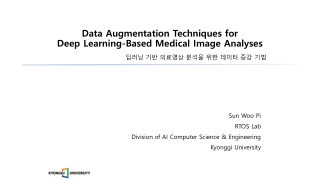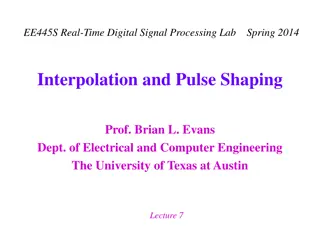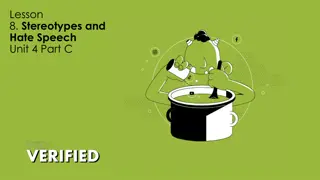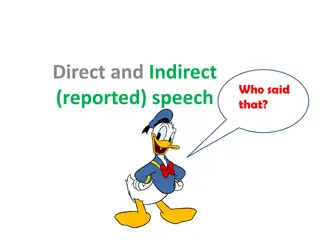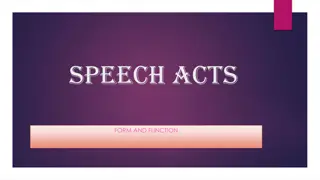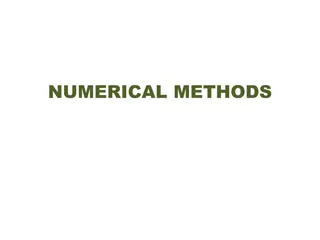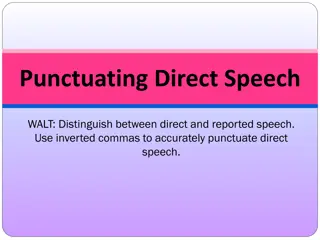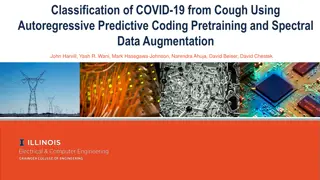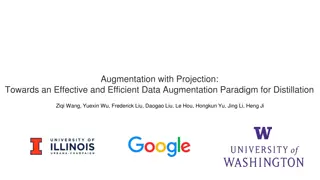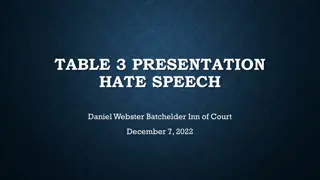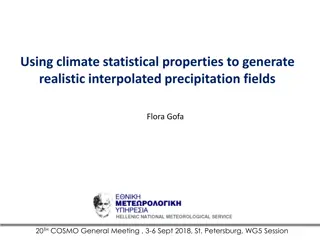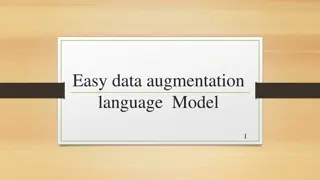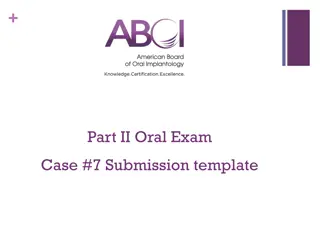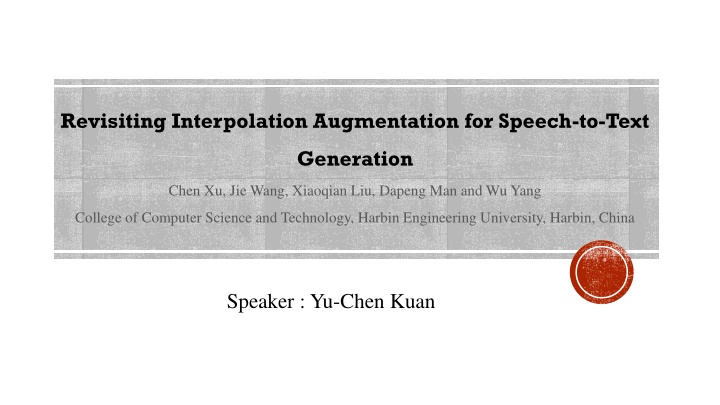
Enhancing Speech-to-Text Generation with Interpolation Augmentation
Explore how Interpolation Augmentation (IPA) improves Speech-to-Text systems in low-resource scenarios by creating virtual samples through linear interpolation. This study combines IPA with existing data augmentation techniques for optimal results in speech recognition tasks.
Download Presentation

Please find below an Image/Link to download the presentation.
The content on the website is provided AS IS for your information and personal use only. It may not be sold, licensed, or shared on other websites without obtaining consent from the author. If you encounter any issues during the download, it is possible that the publisher has removed the file from their server.
You are allowed to download the files provided on this website for personal or commercial use, subject to the condition that they are used lawfully. All files are the property of their respective owners.
The content on the website is provided AS IS for your information and personal use only. It may not be sold, licensed, or shared on other websites without obtaining consent from the author.
E N D
Presentation Transcript
Revisiting Interpolation Augmentation for Speech-to-Text Generation Chen Xu, Jie Wang, Xiaoqian Liu, Dapeng Man and Wu Yang College of Computer Science and Technology, Harbin Engineering University, Harbin, China Speaker : Yu-Chen Kuan
OUTLINE Introduction Experimental Settings Choice of Interpolation Strategy Combination ofAugmentation Techniques Resolution of Specific Issues Effect under Various Scenarios Conclusion 2
Introduction Speech-to-text (S2T) generation systems frequently face challenges in low-resource scenarios To enhance generalization capabilities, data augmentation has become a key strategy such as SpecAugment, random noise and pseudo-data However, above methods often require additional steps and computational resources 4
Introduction In this paper, they resort to interpolation augmentation (IPA), also known as Mixup, a notable method first introduced in image classification IPA mitigates overfitting by constructing virtual samples through linear interpolation of both input features and labels from two randomly selected samples The existing work has not yet established clear guidelines on when and how IPA can be optimally leveraged in S2T tasks 5
Experimental Settings Data augmentation methods typically demonstrate greater potential in low-resource scenarios Various existing data augmentation techniques, such as SpecAugment and speed perturbation, have achieved excellent results In our work, the goal of IPA is to not only lead to isolate improvements but to also work orthogonally with these methods 7
Experimental Settings Analyze with LibriSpeech 100h ASR dataset, report WER on test-clean and test-other sets encoder-decoder (Enc-Dec): encoder 12 Conformer layers, decoder 6 Transformer layers 256 hidden units, 4 attention heads, and 2048 feed-forward sizes CTC applied on top of the encoder, weight of 0.3 encoder CTC (Enc-CTC): 18-layer Conformer encoder, about 30M parameter Initially investigate the effects of IPA on the Enc-Dec model before extending the method to the Enc-CTC model 8
Definition of IPA IPA, commonly known as Mixup Constructs virtual samples in a vicinal distribution by linearly interpolating both the inputs and labels of two randomly selected samples 10
Definition of IPA Considering two samples (xi,yi) and (xj,yj), where x denotes the input features and y represents the corresponding label: when approaching 0, generated samples closely resemble either (xi,yi) or (xj, yj) when approaching + , more balanced interpolation between the two 11
Definition of IPA In practice, IPA randomly replaces a subset of samples with the interpolated versions in each mini-batch, while leaving the remaining samples untouched The selection ratio is typically set to 1, indicating the model is trained completely on the interpolated samples Both and serve as essential hyper-parameters, finding their optimal values often requires careful empirical exploration 12
IPA Strategy in S2T Investigation to the application of IPA within the domain of S2T generation, focusing specifically on ASR and AST tasks Training sample as (s,x,y): s denotes the speech features, x denotes the transcription of s, y denotes the translation in the target language in AST, or the transcription in the case of ASR 13
IPA Strategy in S2T Training objectives in Enc-Dec model: Total loss: 14
IPA Strategy in S2T Several significant distinctions in applying the IPA in S2T tasks The basic decoder processes the embedding sequence as input, the feasibility of directly interpolating word embeddings remains an open question The label in classification tasks often takes the form of a one-hot category The training objectives for CTC and CE are discrete text sequences, and the method to interpolate and learn the label effectively remains an open question 15
IPA Strategy in S2T Consider two arbitrary samples in a batch, denoted as (si,xi,yi) and (sj,xj,yj), interpolate the input: pad the shorter features with zeros to achieve the same length for interpolation Calculate the CTC loss with respect to both labels and interpolate them: 16
IPA Strategy in S2T Similar to the operation in the encoder, which involves interpolating the embeddings zi and zj in the input layer of the decoder: Calculate losses with two labels yi and yj for interpolation: this strategy as embedding interpolation (EIP) 17
IPA Strategy in S2T EIP approach may lead to a disparity between training and decoding During training, the decoder takes the interpolated embedding sequence as input, whereas it receives only a single embedding sequence during inference Investigate an alternative strategy that solely interpolates the encoder input while preserving the original input in the decoder: 18
IPA Strategy in S2T Select from the set {0.2, 0.5, 1.0, 2.0} and from {0.3, 1.0} 19
Preliminary Results Excessive interpolation intensity inversely affects the results, leading to performance degradation Reducing the values of and alleviates this issue EIP strategy promotes a more stable training process, despite a decline in performance 22
Why Does the Combination Fail? Too much noise may result in troubles They think that the noise added by SpecAugment might mess up the interpolation, synthesizing samples that stray too far from the desired vicinal distribution To validate our conjecture, we visualize the data distribution of original and interpolated samples by t-SNE 23
Appending-based IPA To mitigate the problem of distribution shift, we introduce an "appending" operation into the IPA methodology, referred to as AIPA For an original batch comprising n samples, AIPA synthesizes n interpolated samples Concatenated with the original batch, resulting in a new batch size of n (1 + ) for training This simple approach preserves all original samples and generates interpolated ones, thereby safeguarding stable training 25
Appending-based IPA AIPA guarantees exhaustive learning of both the original and vicinal distributions, bridging the divergence between training and inference, as the original samples remain unaltered The distance between the two classes of samples has been significantly minimized 27
Resolution of Specific Issues In the standard implementation, interpolated samples are given the dual responsibility of predicting two corresponding text sequences in both CTC and CE losses This strategy might introduce a risk of ambiguity in the decision boundaries, potentially leading to an over-smoothed model This risk is notably amplified during CTC learning, each output representation is required to cater to a multiplicity of labels 30
Constraint Objective Space Propose constraint objective space (COS), which facilitates CTC learning by replacing the complex traversal with deterministic labels Take the predicted distribution of the original samples as the objective of the interpolated samples for efficiency, calculate COS loss: 31
Constraint Objective Space Formulate the interpolation of the losses as follows: In this framework, the original samples act as a teacher, guiding the more accessible learning process of the interpolated student 32
Constraint Objective Space Similarly, this strategy can be extended to the cross-entropy (CE) loss, denoted by ???, The final training objective thus takes the form: ??? 34
Hyper-parameter AIPA achieves stable results by preserving the original data distribution, and variations in have only a minor impact However, increasing negatively affects the efficacy of the COS method A possible explanation is that a larger results in a more balanced sample interpolation between two original samples, leading to increased COS loss and poor convergence 39
Data Scales 40
Model Backbones incorporating speed perturbation 41
AST Task 42
Conclusion Develop a comprehensive exploration of the interpolation augmentation (IPA) method s application in S2T generation Utilizing IPA alone may not surpass the effectiveness of SpecAugment Defining an appropriate training objective for interpolated samples is of paramount importance IPA demonstrates particular compatibility with the Enc-CTC model 44

